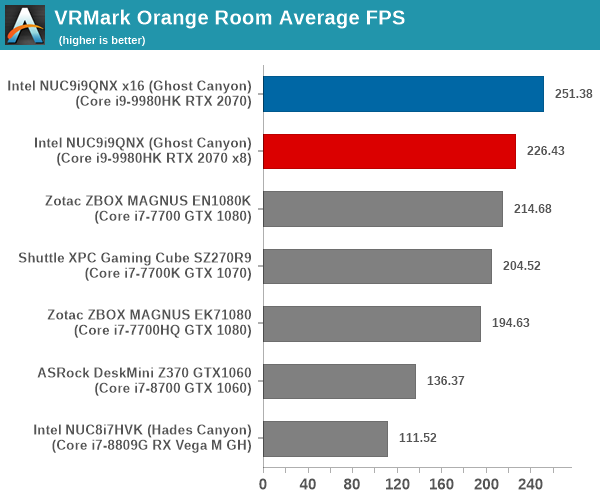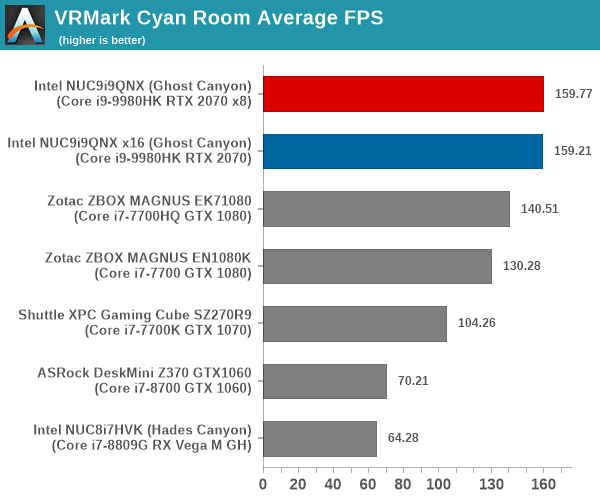Intel Ghost Canyon NUC9i9QNX Review: NUC 9 Extreme Realizes the SFF Dream
by Ganesh T S on April 16, 2020 8:05 AM ESTUL Benchmarks - PCMark, 3DMark, and VRMark
This section deals with a selection of the UL Futuremark benchmarks - PCMark 10, PCMark 8, and 3DMark. While the first two evaluate the system as a whole, 3DMark focuses on the graphics capabilities.
PCMark 10
UL's PCMark 10 evaluates computing systems for various usage scenarios (generic / essential tasks such as web browsing and starting up applications, productivity tasks such as editing spreadsheets and documents, gaming, and digital content creation). We benchmarked select PCs with the PCMark 10 Extended profile and recorded the scores for various scenarios. These scores are heavily influenced by the CPU and GPU in the system, though the RAM and storage device also play a part. The power plan was set to Balanced for all the PCs while processing the PCMark 10 benchmark.





PCMark 8
We continue to present PCMark 8 benchmark results (as those have more comparison points) while our PCMark 10 scores database for systems grows in size. PCMark 8 provides various usage scenarios (home, creative and work) and offers ways to benchmark both baseline (CPU-only) as well as OpenCL accelerated (CPU + GPU) performance. We benchmarked select PCs for the OpenCL accelerated performance in all three usage scenarios.



UL's 3DMark comes with a diverse set of graphics workloads that target different Direct3D feature levels. Correspondingly, the rendering resolutions are also different. The VRMark benchmark targets virtual reality specifically. Its workloads are termed as 'rooms', with each one being a piece of VR content designed to require a specific level of VR performance. We used 3DMark 2.4.4264 and VRMark 1.2.1701 to get an idea of the graphics capabilities of various systems. In this section, we take a look at the performance of the Intel NUC9i9QNX (Ghost Canyon) on a comparative basis across the different workloads.
3DMark Ice Storm
This workload has three levels of varying complexity - the vanilla Ice Storm, Ice Storm Unlimited, and Ice Storm Extreme. It is a cross-platform benchmark (which means that the scores can be compared across different tablets and smartphones as well). All three use DirectX 11 (feature level 9) / OpenGL ES 2.0. While the Extreme renders at 1920 x 1080, the other two render at 1280 x 720. The graphs below present the various Ice Storm worloads' numbers for different systems that we have evaluated.
| UL 3DMark - Ice Storm Workloads | |||

3DMark Cloud Gate
The Cloud Gate workload is meant for notebooks and typical home PCs, and uses DirectX 11 (feature level 10) to render frames at 1280 x 720. The graph below presents the overall score for the workload across all the systems that are being compared.

3DMark Sky Diver
The Sky Diver workload is meant for gaming notebooks and mid-range PCs, and uses DirectX 11 (feature level 11) to render frames at 1920 x 1080. The graph below presents the overall score for the workload across all the systems that are being compared.

3DMark Fire Strike Extreme
The Fire Strike benchmark has three workloads. The base version is meant for high-performance gaming PCs. Similar to Sky Diver, it uses DirectX 11 (feature level 11) to render frames at 1920 x 1080. The Ultra version targets 4K gaming system, and renders at 3840 x 2160. However, we only deal with the Extreme version in our benchmarking - It renders at 2560 x 1440, and targets multi-GPU systems and overclocked PCs. The graph below presents the overall score for the Fire Strike Extreme benchmark across all the systems that are being compared.

3DMark Time Spy
The Time Spy workload has two levels with different complexities. Both use DirectX 12 (feature level 11). However, the plain version targets high-performance gaming PCs with a 2560 x 1440 render resolution, while the Extreme version renders at 3840 x 2160 resolution. The graphs below present both numbers for all the systems that are being compared in this review.
| UL 3DMark - Time Spy Workloads | |||

The VRMark Professional Edition comes with three rooms. Each room can be run either in desktop or HMD mode, with varying minimum requirements for the same workload. The benchmark results include the average FPS achieved, and a score based on the FPS. A pass or fail indicator is also provided based on whether the average FPS exceeds the required FPS. In this section, we take a look at the performance of the Intel NUC9i9QNX (Ghost Canyon) on a comparative basis across the three workloads in desktop mode.
VRMark Orange Room
The Orange Room is meant to test the effectiveness of a system for handling the requirements of the HTC Vive and the Oculus Rift. The recommended hardware for both VR HMDs should be able to easily achieve the desired target FPS (88.9 fps). However, in the desktop mode, the target performance is 109 fps without any frame drops. Systems benching with an average FPS lesser than that are deemed to have failed the VRMark Orange Room benchmark. The graphs below present the average FPS and score for the different systems being considered today.
| UL VRMark - Orange Room | |||

VRMark Cyan Room
The Cyan Room sits between the Orange and Blue rooms in complexity. It is a DirectX 12 benchmark. Similar to the Orange room, the target metrics are 88.9 fps on HMDs and 109 fps on the desktop monitor. The graphs below present the average FPS and score for the different systems being considered today.
| UL VRMark - Cyan Room | |||

VRMark Blue Room
The Blue Room is the most demanding of the three workloads. At the time of introduction of VRMark in October 2016, no publicly available system running as sold was able to pass the test. The Ghost Canyon NUC configuration with the RTX 2070 performs better than any previously benchmarked system, but it still doesn't meet the requirements to pass the VRMark Blue Room test.
The performance of a system in this benchmark is an indicator of its VR-readiness for future generation of HMDs. Similar to the other workloads, the passing performance metrics are 88.9 fps on HMDs and 109 fps on desktop monitors. The complexity of the workload is due to the higher resolution (5012 x 2880) and additional geometry making it necessary to increase the number of Direct3D API calls. The graphs below present the average FPS and score for the different systems being considered today.
| UL VRMark - Blue Room | |||











109 Comments
View All Comments
buckiller - Thursday, April 16, 2020 - link
Power pig. Hades Canyon was great, but this is hot trash, relative to expectations set by last-gen and perf/power capabilities that are possible today.> The Ghost Canyon NUC9i9QNX is a SFF enthusiast's dream come true.
Ooph. Hardly.
Dolda2000 - Thursday, April 16, 2020 - link
I have to admit that I still don't really see the point of this system. It seems that its main gimmick is the fact that what is essentially the motherboard plugs into a PCIe riser card. That's fine and useful and all, but PCIe riser boards and cables are nothing new, and I don't really see what this does that hasn't already been doable for quite some time. You can replace the compute element? Sure, but being able to replace motherboards is nothing new to most form factors. Please do enlighten me if I'm missing something.Dragonstongue - Thursday, April 16, 2020 - link
the series adds the ability for end-users to add a standard PCIe video card to the system system.to the system's system ... or just to the system..
as for folks complain about the price, CPU alone is ~580 USD .. RTX 2070 mini ~539
so there is over $1k right there
I personally wouldn't be buying NUC "overall" based on should be Ryzen A and B absolutely not given seems Intel is "up to their same old BS tricks" via "preventing" folks from offering AMD based options available...
Destoya - Thursday, April 16, 2020 - link
$580 CPU, you have to be kidding. Nobody, including OEMs, pays the tray MSRP intel has listed.If you want to look at it in terms of value, it has the same performance as a Ryzen 3600 ($175)...
Deicidium369 - Thursday, April 16, 2020 - link
First off, there are no OEMs, it is single source Intel. I love Intel NUCs - not sure what the use case for this model is.Namisecond - Friday, April 17, 2020 - link
I don't think Intel manufactures those CPU cards (soldered BGA CPUs). They're probably integrated by a 3rd party OEM like Foxxcon. It's one thing to have engineering samples, but for Intel to step into the motherboard manufacturing game requires a lot of capital resources...unless the NUC parts are actually going to be made at Intel's engineering labs...If it's a production run in the 10Ks...that just might be feasible.Deicidium369 - Friday, April 17, 2020 - link
And like I said there are no OEMs available for you to buy from - single source - Intel. I thought I saw something a few years ago about possibly PNY - I know they do the Nvidia branded graphics cards.BlazingDragon - Thursday, April 16, 2020 - link
The article is misleading... and very Intel biased, IMHO.The ~$1500 USD price is for the i9 barebones kit only... just compute element [w/CPU], daughter board and PSU - i.e. not including a GPU, DRAM memory or SSD - that's why it's so outlandish...
Good ITX m/board & Ryzen 3900x CPU, plus really nice case and PSU is << $900 USD.
Deicidium369 - Thursday, April 16, 2020 - link
So a review of a product from Intel is very Intel biased.... That has to be a huge conspira-plotBlazingDragon - Thursday, April 16, 2020 - link
A review of anything can be positive or negative on that thing... and is unbiased if it seems balanced and fair in that criticism [be it positive or negative].If said article seems to over exaggerate the positives, and/or misrepresent them, and miss out or under call some of the negatives, then yes, it's biased... and IMHO, that's exactly what this article does...